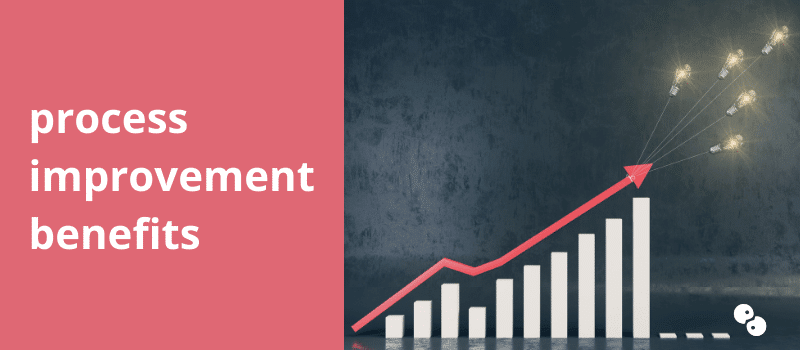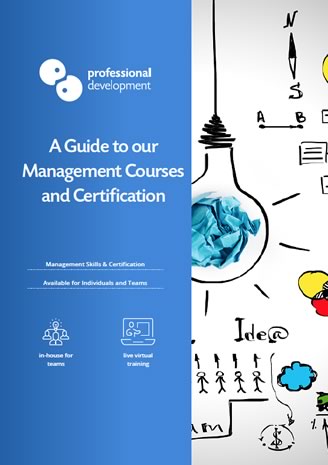With the word “improvement” in its name, you already have a strong clue that a process improvement approach can have many benefits for anything to which you apply it.
Here, we look at specific rewards that adopting this approach can bring to your work and to an organisation as a whole.
We look at 6 key benefits and provide advice on acquiring the know-how you will need to get started using this approach in your work.
Covered in this article:
- What is process improvement?
- Where can it be applied?
- 6 important benefits
- Process improvement methodologies & tools
- Getting the skills and knowledge you need
- Advice and resources
What is process improvement?
Process improvement is a structured, formal approach to analysing how things are done in a specific task or procedure, identifying areas for revision, and applying adjustments where necessary.
Its goals are to:
- eliminate any elements within the process that are wasteful, unnecessary, or do not add value.
- increase efficiency, streamlining the process from start to finish.
- make savings on resources where possible.
- improve the profitability and quality of the overall process.
Where can it be applied?
Although many of the best-known process improvement methodologies were born in the manufacturing sector, it is suitable for and used within every kind of business.
It can be applied within your role, your team, your department, or even your organisation. In fact, adopting a process improvement culture within an organisation can have a transformational effect.
6 important benefits
The benefits are practically limitless. However, in the interest of focus, we have listed 6 key advantages here:
1. Remove Waste
Often, we’re so used to the routine of a process that we don’t see the pockets of wasted time, unnecessary steps, overcomplicated techniques, repetition, and idle downtime that lie within.
Applying a process improvement methodology like lean supports you in both identifying and removing these elements.
2. Increase Efficiency and Productivity
Following an in-depth process improvement review, a task or procedure will undoubtedly be more efficient.
With waste removed and each step optimised and streamlined, it is completed faster. More gets done without losing quality of work.
3. Enhance Quality
While working towards faster, more streamlined cycles, process improvement does not compromise on quality.
In fact, the goal of six sigma is to reduce defects and variations in order to lower the risk of a sub-quality product or service.
Through optimising the process, the outcome will always be improved and you will achieve more consistent quality.
4. Boost Morale and Job Satisfaction
When everything is running more smoothly, people will naturally have a higher level of job satisfaction.
Where there is a culture of innovation and improvement, every member of the team is empowered to contribute observations and ideas that could result in a more finely-tuned procedure.
5. Save Money and Grow Profitability
As you might have guessed from the rewards listed above, process improvement will reliably save your business money.
Through reclaimed resources and reducing errors, you save on outgoing costs. By optimising time and reducing downtime, your team can achieve a lot more within their working hours.
6. Expand Your Business Horizons
When you consistently apply this kind of mindset to each event or task that occurs within your organisation, you arrive at a place where everything is humming along nicely.
At this stage, you leave “fire-fighting” mode and enter an expansion mindset.
Using the savings and improvements you have implemented; you can now explore and invest in growth areas for your organisation.
Process improvement and continuous improvement
While closely related, process improvement and continuous improvement are not quite the same. It is certainly true that those involved with process improvement tend to have a continuous improvement outlook.
Continuous improvement is more of a mindset, a philosophy to adopt and apply throughout your work and strategising.
As the name suggests, this is more of an ongoing method of evaluating and adjusting tasks or process journeys towards optimum performance.
Process improvement methodologies & tools
A quick Google search will bring up a wealth of methodologies that can be used to implement process improvement. They are many and varied, all effective in different situations.
As you research, you will undoubtedly come across the following:
- lean
- six sigma
- lean six sigma
- business process managememt (BPM)
- Kaizen
- total quality management (TQM)
- PDCA (plan, do, control, act)
- 5S
- DMAIC
- DMADV
Sometimes, process improvement tools are listed as methodologies which can make getting started seem like a steep mountain to climb.
Read on for some guidance on this topic…
Getting the skills and knowledge you need
Perhaps the best-known of all methodologies here are lean and six sigma, often combined as lean six sigma.
The most efficient way to cover a lot of ground is by completing lean six sigma training.
Lean and six sigma, whether used together or separately, usually cover most key process improvement tools and techniques.
For example, here is just a selection of what is covered during our 5-day Lean Six Sigma Green Belt Course:
- The DMAIC cycle
- SIPOC
- Value Stream Maps
- Control Charts
- Pareto Analysis
- FMEA
- Kaizen Events
- 5S
- Total Preventative Maintenance (TPM)
- KanBans
- PDCA Cycle
You can read the full outline of tools explored on this programme by downloading our PDF brochure.
Through completing a lean six sigma course that is both broad-ranging in content and practical in style, you will gain a strong foundation in process improvement capabilities.
Advice and resources
Want to get started but unsure where to begin? Ready for more reading on this topic? Prefer to speak with someone for advice specific to your situation?
Here are some helpful channels for taking the next steps:
-
Get Tailored Advice
Our training consultants can offer guidance on the right steps for your development.
Whether you want to get trained and certified for your own career progression or would like to begin introducing a process improvement culture to your team or organisation, we can help.
You can call us directly at Freephone 1800 910 810 or use the button below to ask a question online.
Get a Brochure -
Get a Complete PDF Guide
Download our detailed PDF Guide to Lean Six Sigma for more insights and knowledge on lean six sigma and getting certified.
This guide includes topics such as: the difference between lean and six sigma, the value of lean six sigma certification, and understanding lean six sigma belts and roles.
-
Continue Reading
Here are our recommendations for your next reads in this area:
What are Lean Six Sigma Belts? A 3-minute guide to the different belt levels within the lean six sigma hierarchy.
Asana.com’s introductory guide to process improvement methodologies.


